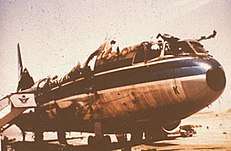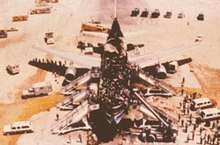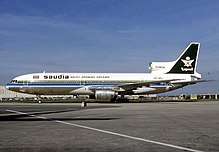Saudia Flight 163
Saudia Flight 163 was a scheduled Saudia passenger flight that caught fire after takeoff from Riyadh International Airport (now the Riyadh Air Base) en route to Jeddah, Saudi Arabia[1] on 19 August 1980. All 287 passengers and 14 crew on board the Lockheed L-1011-200 TriStar died from smoke inhalation after the aircraft made a successful emergency landing at Riyadh.
 The remains of HZ-AHK, after the fire | |
| Accident | |
|---|---|
| Date | 19 August 1980 |
| Summary | In-flight fire in cargo hold |
| Site | Riyadh International Airport Riyadh, Saudi Arabia 24°42′42″N 46°43′37″E |
| Aircraft | |
| Aircraft type | Lockheed L-1011-200 TriStar |
| Operator | Saudia |
| IATA flight No. | SV163 |
| ICAO flight No. | SVA163 |
| Call sign | SAUDIA 163 |
| Registration | HZ-AHK |
| Flight origin | Quaid-e-Azam Int'l Airport Karachi, Pakistan |
| Stopover | Riyadh International Airport Riyadh, Saudi Arabia |
| Destination | Jeddah International Airport Jeddah, Saudi Arabia |
| Occupants | 301 |
| Passengers | 287 |
| Crew | 14 |
| Fatalities | 301 |
| Survivors | 0 |
The accident is the deadliest involving a Lockheed L-1011 TriStar,[2] as well as the deadliest aviation disaster to occur in Saudi Arabia.[3]
Accident

Flight 163 departed Qu'aid-e-Azam International Airport (now Jinnah International Airport) in Karachi, Pakistan at 18:32 Pakistan time (13:32 UTC) bound for Jeddah International Airport in Jeddah, Saudi Arabia, with a scheduled intermediate stop at Riyadh Airport. The flight arrived in Riyadh at 19:06 Saudi time (16:06 UTC). There was a two-hour layover for refueling. During the layover several of the passengers disembarked. After refueling, the flight took off at 21:08 (18:08 UTC) bound for Jeddah.
Almost seven minutes into the flight the crew received warnings of smoke from the cargo compartment.[4]:66–67,98 The next four minutes were spent by the crew trying to confirm the warnings, after which Flight Engineer Bradley Curtis went back into the cabin to confirm the presence of smoke. Captain Mohammed Ali Khowyter decided to return to the airport, and First Officer Sami Abdullah M. Hasanain radioed their intentions at 21:20 (18:20 UTC). At 21:25 (18:25 UTC), the thrust lever for the number two engine (the center engine) became jammed as the fire burned through the operating cable. Then, at 21:29 (18:29 UTC), the engine was shut down during final approach.
At 21:35 (18:35 UTC), Khowyter declared an emergency and landed back at Riyadh.[5] After touchdown at 21:36 (18:36 UTC), the airplane continued to a taxiway at the end of the runway where it exited the runway, stopping two minutes and 40 seconds after touchdown at 21:39 (18:39 UTC). The airport fire rescue equipment was stationed back on the landing section of the runway, with emergency personnel expecting an emergency stop and evacuation. This meant they had to rush after the aircraft, which had used the entire length of a 13,000 feet (4,000 m) runway to slow and then exit onto the taxiway. The airplane stopped facing in the opposite direction from landing.
Once the aircraft had stopped, the crew reported that they were shutting down the engines and about to evacuate. On arrival at the aircraft soon after, however, the rescue personnel found that the two wing-mounted engines were still running, preventing them from opening the doors. These were finally shut down at 21:42 (18:42 UTC), three minutes and 15 seconds after the aircraft came to a stop, at which point communication with the crew was lost. No external fire was visible at this time, but flames were observed through the windows at the rear of the aircraft. Twenty-three minutes after engine shutdown, at 22:05 (19:05 UTC), the R2 door (second door on the right side) was opened by ground personnel. Three minutes later, the aircraft burst into flames, and was consumed by fire.[4]:8
Why Captain Khowyter failed to evacuate the aircraft promptly is not known. Saudi reports stated that the crew could not get the plug-type doors to open in time.[6] It is assumed that most passengers and flight attendants were incapacitated during the landing roll, or they did not attempt to open a door on a moving aircraft.[7] It is known that the aircraft remained pressurized during the landing roll as the cabin pressurization system was on standby, and the aircraft was found with both pressurization hatches almost completely closed. The pressurization hatches should have opened completely on touchdown to depressurize the aircraft. The crew were found still in their seats, and all the victims were found in the forward half of the fuselage. Autopsies were conducted on some of the non-Saudi nationals, including the American flight engineer. All of them perished from smoke inhalation and not burns, which indicated that they had died long before the R2 door was opened. The source of the fire in compartment C3 could not be determined.[4]:78
Aircraft

The aircraft involved in the accident was a Lockheed L-1011 TriStar (Registered in Saudi Arabia as HZ-AHK). It made its first flight on 13 July 1979, and was delivered to Saudia on 21 August 1979.[4]:89[8]
Crew
The captain of the flight was 38-year-old Mohammed Ali Khowyter, a Saudi who was hired by Saudia in 1965. He had flown numerous aircraft such as Douglas DC-3, DC-4, McDonnell Douglas DC-9, Boeing 707 and 737. Khowyter's records described him as a slow learner and needing more proper training. Khowyter had 7,674 flying hours, including 388 hours in the TriStar. The first officer was 26-year-old Sami Abdullah M. Hasanain, who joined the airline in 1977 and had previously worked as a trainee. He received his type rating on the TriStar eleven days before the accident. At one point during his training, however, due to his poor performance, Hasanain was removed from flying school. Hasanain had 1,615 flying hours, including 125 hours in the TriStar. The flight engineer was 42-year-old Bradley Curtis, an American who was hired by the airline in 1974. He had been qualified as a captain of the Douglas DC-3, and was then assigned to train in either the Boeing 707 or 737, but failed to qualify as both a captain and as a first officer because he did not meet the requirements. He had needed to pay for his own training as an L-1011 flight engineer in order to keep his job. Curtis had 650 flying hours, including 157 hours in the TriStar.[4]:86–88[9]
Passengers
| Nationality | Number |
|---|---|
| Canada | 1 |
| China | 1 |
| Finland | 1 |
| France | 1 |
| West Germany | 1 |
| Iran | 32 |
| Ireland | 1 |
| Italy | 1 |
| Japan | 1 |
| South Korea | 1 |
| Netherlands | 1 |
| Pakistan | 85 |
| Philippines | 6 |
| Saudi Arabia | 154 |
| Spain | 1 |
| Taiwan | 1 |
| Thailand | 2 |
| United Kingdom | 4 |
| United States | 3 |
| Total | 301 |
Eighty-two of the passengers boarded in Karachi while the remaining 205 passengers boarded in Riyadh. The majority of the passengers were Saudis and Pakistani religious pilgrims on their way to Mecca for a traditional Ramadan holiday. In addition to the Saudis and Pakistanis, there were 32 religious pilgrims from Iran. There were also a small number of passengers from various countries, who were heading to Jeddah for diplomatic missions.[4]:89[10][11]
Investigation

The investigation revealed the fire had started in the aft C3 cargo compartment.[4]:77–78 The fire was intense enough to burn through the cabin floor, causing passengers seated in that area of the cabin to move forward prior to the landing. Saudi officials found two butane stoves in the burned-out remains of the airliner, and a used fire extinguisher near one of them.[4]:35 One early theory was that the fire began in the passenger cabin when a passenger used his own butane stove to heat water for tea.[12] The investigation found no evidence to support this theory.[4]:78
Policy changes
After the event, the airline revised its training and emergency procedures. Lockheed also removed the insulation from above the rear cargo area, and added glass laminate structural reinforcement. The National Transportation Safety Board recommended that aircraft use halomethane extinguishers instead of traditional hand-held fire extinguishers.[11]
Crew resource management
Flight 163 encapsulated the further need for an advent of crew resource management. This is evident from the primary lapses in effective communication that prevented the crew from carrying out a final successful evacuation from the aircraft. These lapses are enabled in part by so-called "power distances" between juniors and superiors in workplace settings, relationships found in all societies but emphasized more so in some than in others.[13] "In high power distance cultures, juniors do not question superiors and leaders may be autocratic", leading to situations where a first officer finds it difficult to question decisions made by the captain, conditions that may have been present on Saudia Flight 163.[14][13][15] This phenomenon has the capability of affecting flight safety globally, but as the work performed in the cockpit is markedly dependent upon the ability of one worker to crosscheck the work of another and vice versa, the danger is most apparent in individuals brought up in cultures that traditionally revere high-power distances between those in positions of power and their subordinates.[14] In 1982, the British current-affairs program World in Action aired an episode entitled "The Mystery of Flight 163". This documented the accident, and was subsequently used to train pilots in the value of crew resource management.[16]
References
- Ranter, Harro. "ASN Aircraft accident Lockheed L-1011 Tristar 200 HZ-AHK Riyad International Airport (RUH)". aviation-safety.net. Aviation Safety Network.
- Ranter, Harro. "Aviation Safety Network > ASN Aviation Safety Database > Aircraft type index > Lockheed L-1011 TriStar". aviation-safety.net. Retrieved 23 January 2019.
- Ranter, Harro. "Aviation Safety Network > ASN Aviation Safety Database > Geographical regions > Saudi Arabia air safety profile". aviation-safety.net. Retrieved 23 January 2019.
- "Aircraft Accident Report, Saudi Arabian Airlines Lockheed L-1011, HZ-AHK, Riyadh, Saudi Arabia August 19th, 1980" (PDF). Federal Aviation Administration. Saudi Arabian Presidency of Civil Aviation. Archived from the original (PDF) on 31 December 2013. Retrieved 26 February 2017.
- "265 Are Feared Dead As Saudi Plane Burns In Landing at Riyadh". The New York Times. UPI. 20 August 1980. ISSN 0362-4331. Retrieved 26 February 2017.
- "Saudi Fire Negligence Suit Filed". Air Transport. Aviation Week & Space Technology. 27 October 1980. p. 32.
- Witkin, Richard (21 August 1980). "Fire on Saudi Plane Believed to Have Started in Cabin: Cockpit Escape Hatch Not Used". The New York Times. NYTimes Co. ISSN 0362-4331. Retrieved 26 February 2017.
- "Saudia HZ-AHK (Lockheed L-1011 TriStar - MSN 1169)". Airfleets aviation. Retrieved 28 February 2018.
- Thomson, Jim (16 January 1982). "Human behaviour in a crisis – Saudia 163" (PDF). Retrieved 2 March 2018.
- "Mecca pilgrims among victims Gas stoves found in burned plane". The Globe and Mail. 29 August 1980.
- Haine, Edgar A. (2000). Disaster in the Air. Associated University Presses. pp. 67–69. ISBN 9780845347775.
- "Jetliner fire first started by stove; death toll set at 301". The Morning Record and Journal. United Press International. 21 August 1980. p. 22.
- Helmreich, Robert L.; Davies, Jan (2004). "Culture, Threat, and Error: Lessons from Aviation" (PDF). Canadian Journal of Anesthesia. 51 (6): R2. doi:10.1007/bf03018331.
- Trkovsky, Josef (2017). Improved Flight Safety Through Effective Communication Among Multicultural Flight Crew (Ph.D. thesis). Scottsdale, Arizona: Northcentral University. pp. 4, 6–7, 104–114. Dissertation No.10278679 – via ProQuest Dissertations Publishing.
- Helmreich, RL; Klinect, JR; Wilhelm, JA; Merritt, AC (2001). "Culture, Error, and Crew Resource Management". In Salas, Eduardo; Bowers, Clint A; Edens, Eleana (eds.). Improving Teamwork in Organizations: Applications of Resource Management Training. Lawrence Erlbaum Associates. ISBN 0805828443. OCLC 46790778.
- Karlins, Marvin; Koh, Freddie; McCully, Len; Chan, C. T. "CRM for CRM: Cockpit Relevant Movies for Crew Resource Management". The CRM Advocate.
External links
- Burian, Barbara K. (2006). "Aeronautical Emergency and Abnormal Checklists: Expectations and Realities" (PDF). NASA Ames Research Center. Retrieved 12 January 2017.
- Thomson, Jim (2013). "Human Behaviour in a Crisis – The Saudia 163 Accident, 1980" (PDF). Safetyinengineering.com. Retrieved 12 January 2017.
- Final Accident Report – General Authority of Civil Aviation
- Picture at PlaneCrashInfo.Com
- Cockpit voice recorder transcript
- AirDisaster.Com Description (Main Database)
- PlaneCrashInfo.Com article on Saudia 163